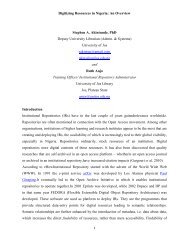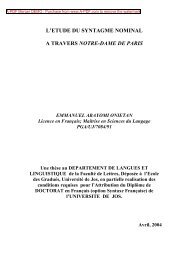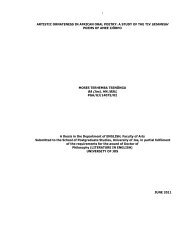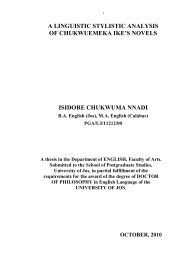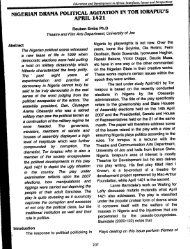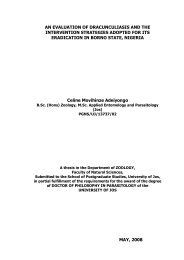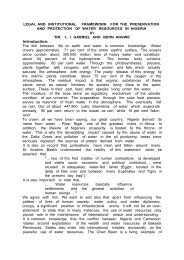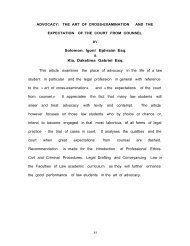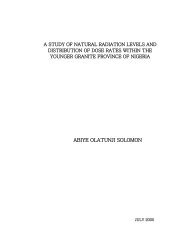Professor Atiene Solomon Sagay - University of Jos Institutional ...
Professor Atiene Solomon Sagay - University of Jos Institutional ...
Professor Atiene Solomon Sagay - University of Jos Institutional ...
You also want an ePaper? Increase the reach of your titles
YUMPU automatically turns print PDFs into web optimized ePapers that Google loves.
Outcome <strong>of</strong> PMTCT interventions in Nigeria<br />
We have analysed the mother-to-child transmission (MTCT) rates following various<br />
interventions at JUTH and these are shown in green bars in figure 9 above. The transmission<br />
rates at 6 weeks <strong>of</strong> age are compared with MTCT rates in Botswana, a country that can boast <strong>of</strong><br />
some <strong>of</strong> the best PMTCT programs in Africa.<br />
15%<br />
10%<br />
5%<br />
0%<br />
Figure 9: ARV Interventions and<br />
MTCT [Nigeria vs. Botswana]<br />
BOTSWANA<br />
JOS, NIGERIA<br />
0.7%<br />
0.9%<br />
2.3%<br />
3.3%<br />
2.9%<br />
Pre-preg During 4wks<br />
HAART AZT+sdNVP<br />
4.7%<br />
24<br />
7.0%<br />
5.2%<br />
sdNVP<br />
alone<br />
12.3%<br />
12.6%<br />
No ART<br />
Clearly, outcomes in our programme are comparable indicating that our interventions are<br />
working like elsewhere in the world.<br />
Infant feeding and MTCT between 6wks and 6months<br />
One <strong>of</strong> the strategies to reduce postnatal mother to child transmission (MTCT) <strong>of</strong> HIV is the use<br />
<strong>of</strong> replacement feeding (BMS) which is expected to eliminate transmission through breast milk.<br />
To achieve this goal, BMS must be practiced in a setting where it is culturally acceptable,<br />
feasible, affordable, sustainable and safe (AFASS), otherwise, there is increased risk <strong>of</strong> infant<br />
morbidity and mortality.<br />
The vast majority <strong>of</strong> our HIV infected mothers are provided with infant formula (BMS) to<br />
prevent HIV transmission to their babies. Our recent unpublished study compared the risk <strong>of</strong><br />
postnatal transmission <strong>of</strong> HIV at 6 months among infants who are HIV negative at 6 weeks <strong>of</strong><br />
age and were exclusively breast fed or given exclusive replacement feeding in the PMTCT<br />
program at JUTH, <strong>Jos</strong>, Nigeria. The difference in transmission risk between the two feeding<br />
methods was not statistically significant (1.8% vs 2.2%; P value =0.785). This finding showed<br />
that many mothers in the BMS group were practicing mixed feeding. New guidelines endorse<br />
administration <strong>of</strong> antiretroviral drugs to make breast feeding safer. It is hoped that this strategy<br />
will improve child survival without increasing HIV transmission to the infant.




